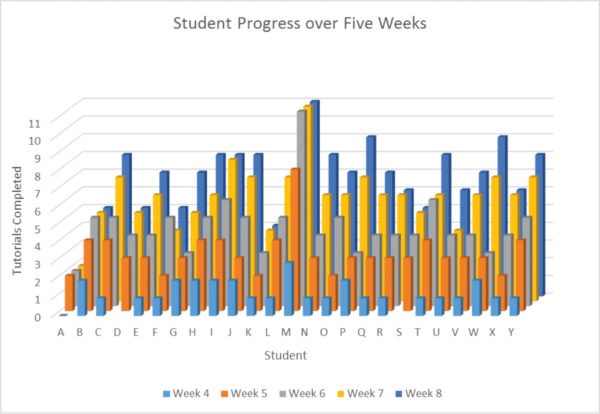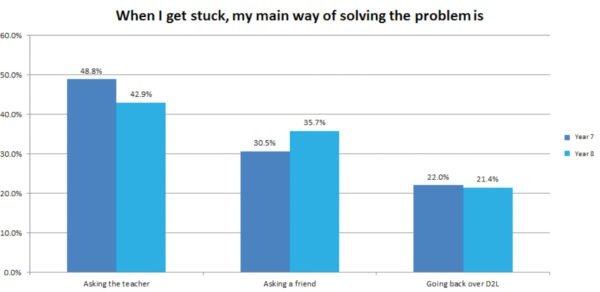The role of the teacher in the self-paced Blended Learning classroom is quite different to the role in a traditional classroom.
However, it is very different to the preconceived idea that some people have; where the students work on a computer and the teacher has an ‘easy’ time, sitting at his/her desk, doing other work or generally not engaging with the students as they are ‘doing their tutorials / online work / activities’. The teacher in a self-paced Blended Learning classroom should be very active. Even when each student is working well unassisted, the teacher should be actively looking at the work being done, providing feedback, and encouragement and fine tuning the learning. There is usually very little time to ‘take it easy’ as the teacher works to increase the efficiency and effectiveness of learning and to build relationships. This building of relationships is vital. Teachers who have never taught effectively in this type of environment sometimes have the impression that it is impersonal. The reality is that it is very personal, as the interactions are generally around individuals and small groups rather than just large groups.
The self-paced Blended Learning classroom should combine the best of technology assisted learning with the best of teacher assisted learning.
The location of each student in the learning spectrum in this environment is unique. One student may be ‘behind’ the location provided in the ‘learning timeline’, another may have completed almost all activities, while another may be at the recommended location. Thus, ‘teaching’ the class as one group is rare. It may happen, but only when there is a major point that all students need to have clarified. More often than not, this occurs at the start of a ‘lesson’ or at the end of a ‘lesson’, and it exists more to disseminate information that the entire group needs rather than to ‘teach’. For example, the teacher may start the lesson by reinforcing the timeline, asking what work students have completed, or reinforcing some general learning concepts. It is also a useful way to focus students on the work for the lesson.

A typical self-paced BlendedLearning class showing the ‘spread’ of completion of ‘learning’ over a five week period. Note that the pace of work varies for each student.
In this type of classroom, the teacher is much more of a facilitator than a group instructor. Students are encouraged to ask questions when they have difficulties understanding an instruction or a concept. The teacher actively walks around the room, asking questions to check understanding and answering questions as required. It is important that the teacher creates a classroom environment that fosters and encourages inquiry and questioning, where students are comfortable with asking questions and exploring to overcome uncertainty without criticism or fear of failure. It is also vital that the teacher does not leave a student with a question until a solution has been provided. These methods of answering questions are not new or unique to this style of learning. They have existed in classrooms for decades. However, in a self-paced Blended Learning Classroom the teacher needs to be very aware of the possibilities as they are a common, integral part of the minute-by-minute teaching and learning process.

Student surveys indicate that the teacher is a vital part of the self-paced Blended LearningClassroom, and is the main source of solutions when a student requires clarification of a concept. In this survey, D2L stands for Desire2Learn, the Online Learning Environment used by the students.
However, the method used by a teacher to answer a question may vary.
- Do it for them: This is the least preferred method. Simply providing the answer without explanation and checking for understanding does little to improve student learning.
- Do it for them and provide explanation: This is a better method, but still requires little active participation on the part of the student. It may be effective with a student who is focussed and concentrating. A good teacher knows when this is appropriate, and which students in their class will learn from this. It may be a quick and efficient way to assist a motivated and academically capable student.
- Have them ‘do it’ while guiding them to a solution: This involves the student much more than the two previous methods. The teacher asks questions, possibly having the student backtrack through a tutorial, article or activity, until the point where the problem arose was encountered. A student may also be guided to search for a solution online (rather than being told to look online and then left to their own devices without feedback) … there are many possibilities. Through careful questioning and guidance, the student may ‘discover the solution for himself/herself’. This method also teaches the student how to overcome a learning barrier; it teaches resilience and goes beyond simply the solution to the current problem by teaching strategies to overcome future learning roadblocks.
- Peer teaching: This can be a powerful teaching tool. It can be very useful in a situation where there are many students in the classroom who have a (different) question at the same time, and it would take quite a while for the teacher to help each one. Students learn well from other students. Students who assist other students have to clarify their understanding in order to successfully ‘teach’ another student. Thus, it can consolidate the peer teacher’s learning. Learning no longer relies on just the teacher. Each person wins. Sometimes the teacher’s role in this type of ‘classroom’ is knowing the level of understanding of the students in order to connect a peer teacher (a student with knowledge of that topic) with a student who has a question. This can even occur by asking the class ‘Who knows how to…’. A student who responds positively can be asked to teach the other student. There should be ‘ground rules’ in this situation. The class needs to know that the peer teacher cannot simply solve the problem for the student who has the question. Instead, the peer teacher should guide the student to the solution while providing explanation. As an example, a rule that no student may touch another student’s mouse or keyboard has proved to be very effective in technology subjects. This prevents the peer teacher from ‘doing’ it for them and it helps to produce a situation where the peer teacher must explain and guide to a solution, increasing understanding in the process. In a more traditional class, a rule that a peer teacher should use a pen minimally could apply. This encourages the student to do most of the writing, interpreting the explanation of the peer teacher and thus actively engaging in the process. This interpreting of the explanation while moving toward a correct solution is a key part of the process.
- Mini lessons: The same question may be asked by a number of students over a period of time. This points to a scenario where either the instructional material needs to be improved as it does not clearly explain a concept, or where the concept is difficult for students of that age or with that level of background information. In this case, it is useful to ask the students who would like clarification of the concept. It is likely that a subset of the class (Five students? Ten students?) is in this situation. In this case, it would be useful to gather those students together to have a more traditional teaching moment – the sage on the stage still has a place in this type of learning environment. The point to note is that the remainder of the class does not have to pause in their learning while this occurs. There will be students in the class who already understand the concept; there is no need to waste their time. There will be students in the class who are not at that point where they realise that they have a problem with this yet – they are not ‘up to that point’ yet; it may be better to leave them working and uninterrupted. When they are ready for that information, they will ask. It is all a matter of readiness.
- Traditional teaching to the whole class: This can be useful when covering a very difficult concept, but even then experience has shown that there are usually one or two students in the room who have a full understanding of that concept. They should be allowed to continue work while the majority of the class is ‘taught’. The alternative is that these ‘advanced’ students are wasting time or may simply be bored.
Experience has also shown that there will be some students who are not ready for an explanation of that concept yet. In this case, the teaching will be ineffective and time will again be wasted. It is probably better to allow these students to continue working at their own pace, and to teach them the concept at a later time.
Teaching in a self-paced Blended Learning classroom is a significant change, even though it draws on teaching skills, such as those just mentioned, that have existed for decades. However, the change in instructional technique is significant and is worth the effort as it individualises learning and allows the teacher to focus on the core of the teaching and learning process.


Latest posts by Peter West (see all)
- The 20:20:60 Rule of eLearning Evolution - October 11, 2022
- Is your school ready for an LMS? – The Data Design Continuum (DDC) - August 25, 2022
- Is your school ready for an LMS? – The Course Design Continuum (CDC) - September 7, 2021
You must be logged in to post a comment.


There are no comments
Add yours